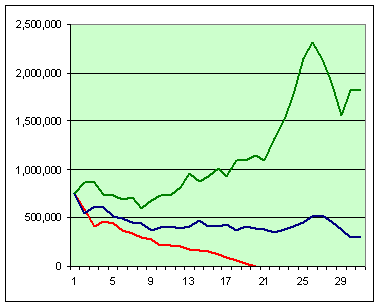cute fuzzy bunny
Give me a museum and I'll fill it. (Picasso) Give me a forum ...
Give or take. Unless a lot of stuffs different. In which case nevermind.
Well, 2007 is not going to be independent of 2006, and July is not going to be independent of June. If we tried to model what was going to happen in 2007 or in July, and we abandoned the conditions leading up to those times, we might be able to claim "independence" but we won't learn more -- we'll have shuffled the data and pretended to get more data points by using them in a different order, but by doing so, we will have given up what made the data meaningful in the first place.
The problem that causes almost all failures is a prolonged (3-5 year) down market shortly after retirement. Eating into the principal so much during that prolonged period just doesn't leave enough to recover.
Randomizing the selection of years would make meaningless the one primary cause of failure -- sequential years with down markets, occuring shortly after retirement.

My plan is to move in with relatives.Cute n Fuzzy Bun'ny said:... If you run into a long crappy period, have a plan for that but know that everyone else is also having a tough time and its all relative.
kate said:I got a very good feel for the numbers using FireCalc, and then decided to do it my own way. Using the divs/interest from my taxable account, I have what I need. The IRAs, future SS, and my parents' trustcan take care of any surprises. More than anything else, I want simplicity and hands off and spending my time on other things.
dory36 said:What, you think you're retired or something!?!
